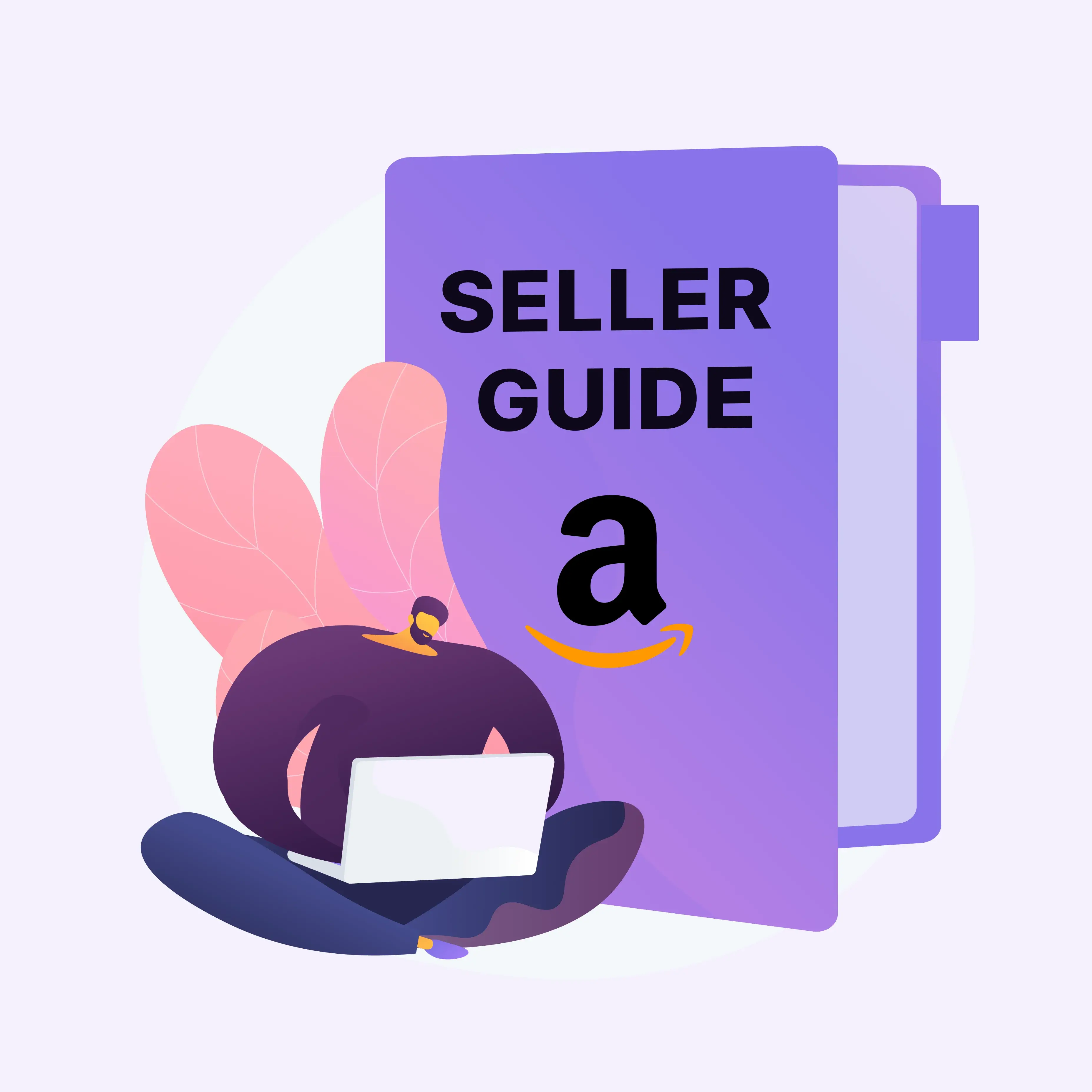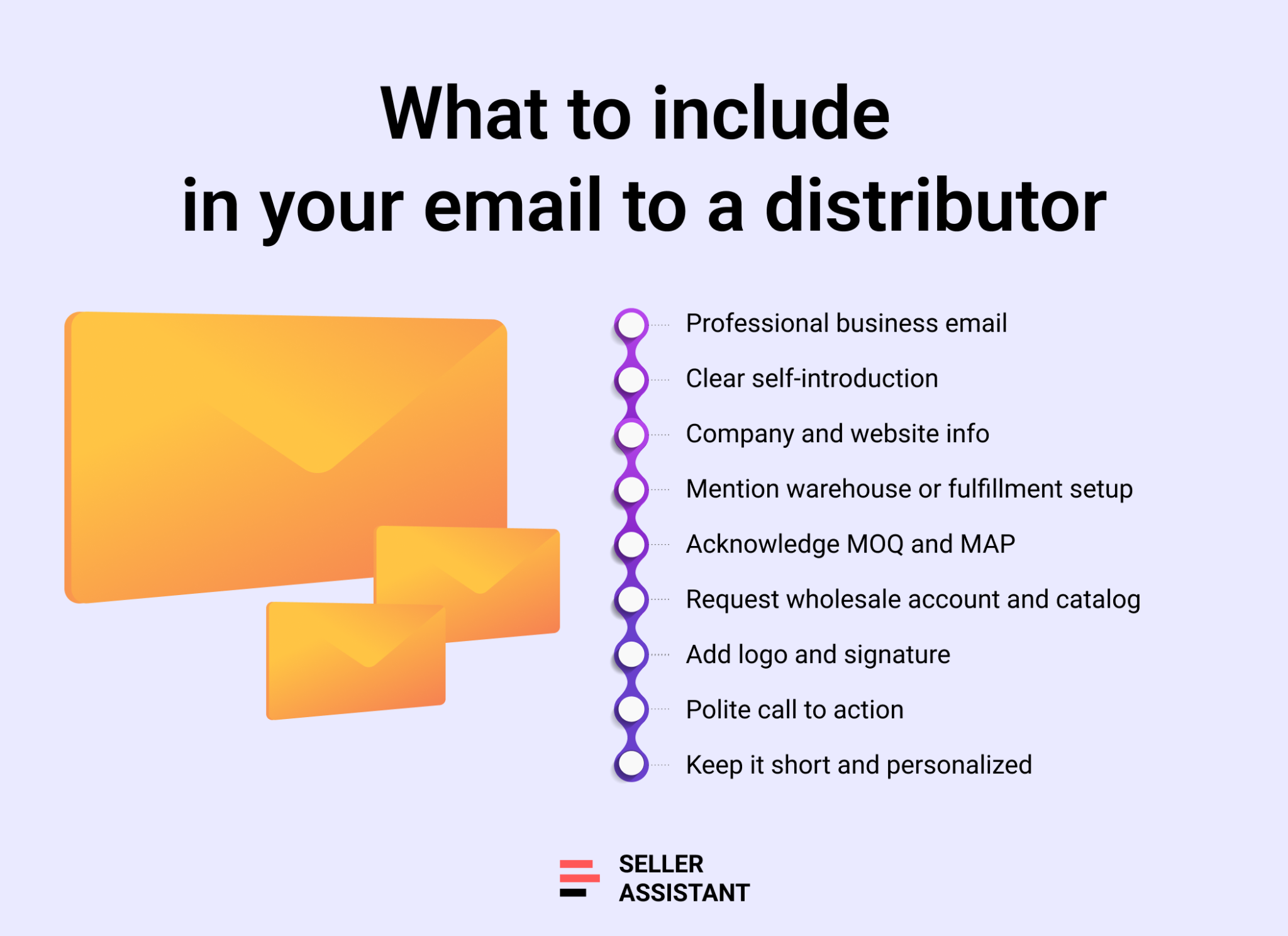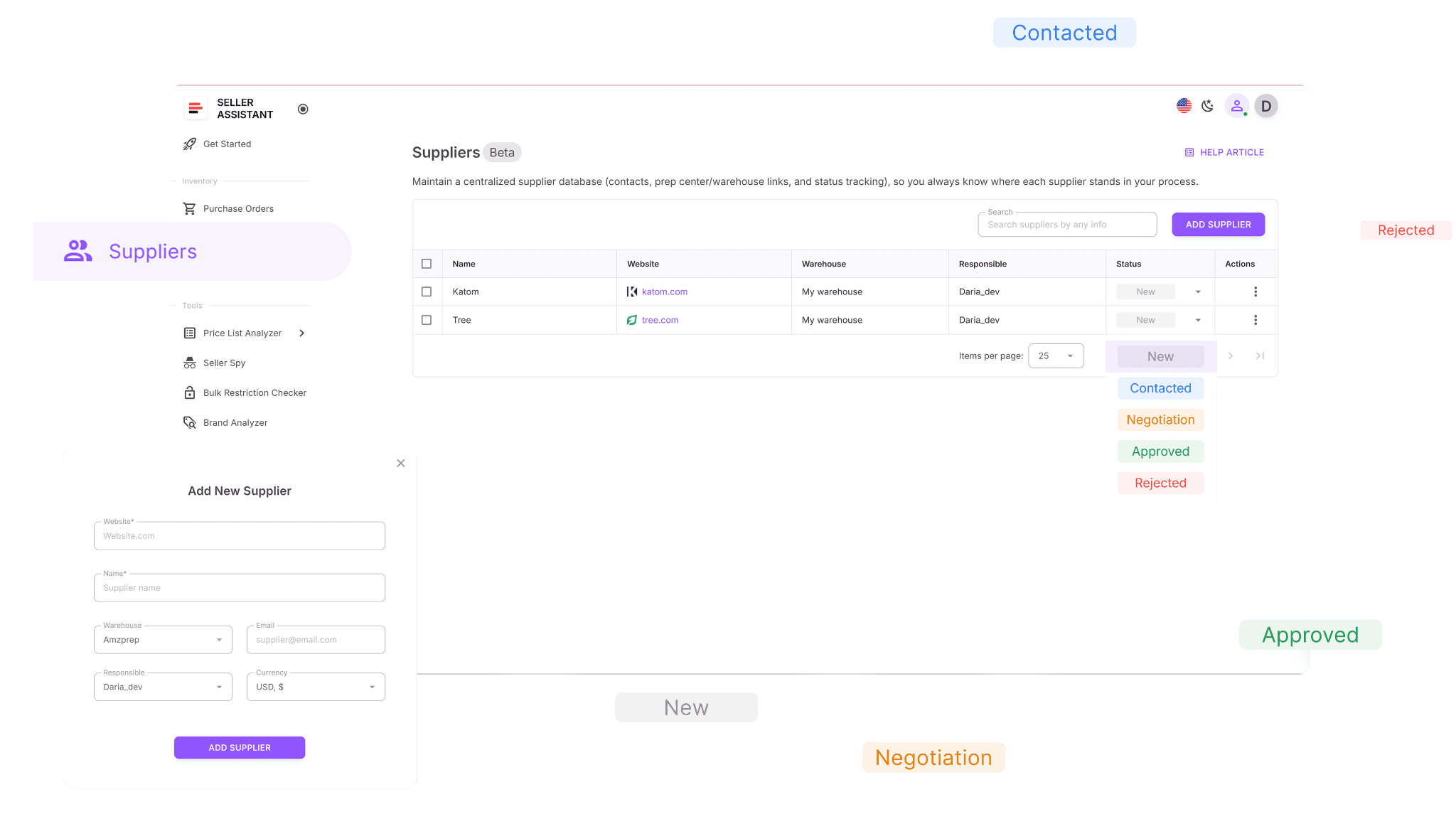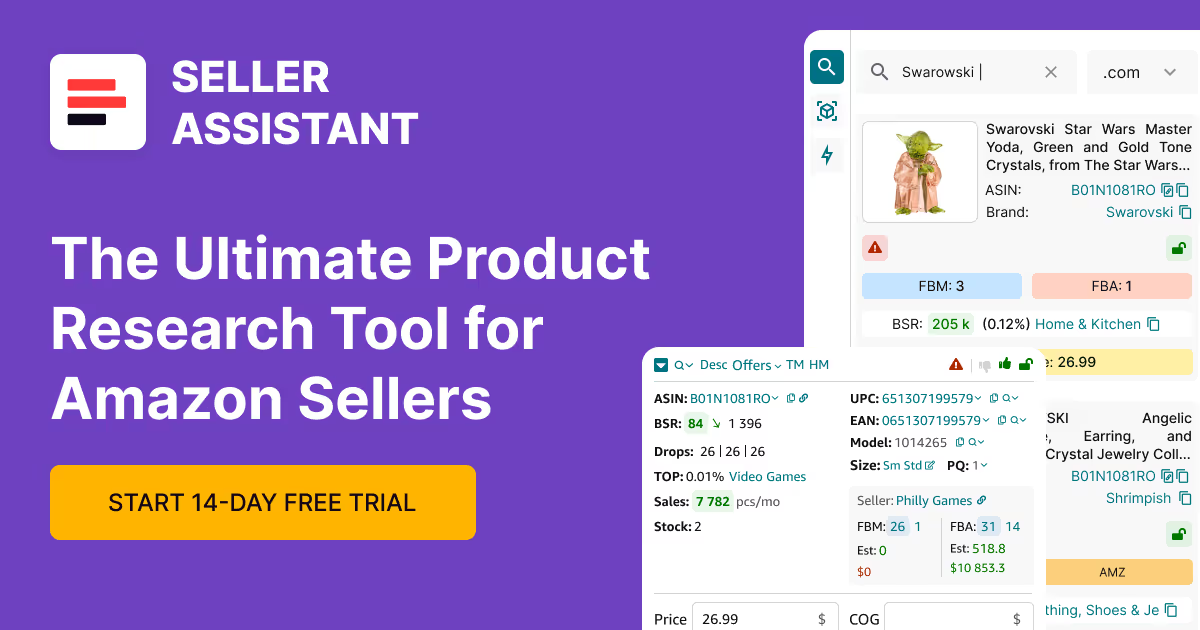How to Write a Professional Email to a Wholesale Distributor (+ Templates)
Download Amazon Seller Guide
This guide will help you get started, understand the basics of Amazon selling, and explain in simple words how it all works.

Finding a rock-solid wholesale distributor for Amazon isn’t luck – it’s a grind. Most sellers ping hundreds… sometimes a thousand… to land 5–10 suppliers. That’s why your first touch – the email – matters.
A clean, credible message gets you past the gatekeeper, unlocks a wholesale application, and puts a price list in your inbox.
In this post, we’ll show you how to prepare your business profile, what to include (and avoid) in your outreach, and how to request the right assets. Then we’ll show how to analyze supplier catalogs with Seller Assistant's Price List Analyzer to spot profitable ASINs. Finish strong with three copy-ready email templates for sellers.
Note. Seller Assistant is an end-to-end Amazon workflow management platform that integrates 10+ wholesale-focused solutions into one connected system. It combines sourcing workflow automation, bulk research and intelligence tools, and integrated Chrome extensions – giving you everything you need to streamline finding deals, managing suppliers, and creating purchase orders.

The platform aggregates: workflow management tools – Purchase Orders Module, Suppliers Database, Warehouses Database to organize, automate, and scale every step of your wholesale and arbitrage operations; bulk research & sourcing tools – Price List Analyzer, Bulk Restriction Checker, Sourcing AI, Brand Analyzer, Seller Spy to evaluate supplier price lists, verify selling eligibility and restrictions, open new brands, and discover winning product ideas from competitors to expand your product catalog; Chrome extensions – Seller Assistant Browser Extension, IP-Alert Extension, and built-in VPN by Seller Assistant to deep-research products, check IP claims and compliance, and access geoblocked supplier sites directly within your browser; and integrations & team access features – seamless API connectivity and integrations with Zapier, Airtable, and Make, plus Virtual Assistant Accounts for secure, scalable team collaboration.
With Seller Assistant, every step of your Amazon wholesale and arbitrage workflow is automated and connected.
Why Your Distributor Email Matters More Than You Think
When you start building your wholesale business, your first real connection with a distributor happens through email. It’s your digital handshake – the message that determines whether you’ll be ignored or invited to open an account. Writing the right email can unlock access to wholesale catalogs, better pricing, and long-term supplier partnerships that fuel your Amazon business growth.
First impressions decide everything
Distributors receive hundreds of emails from Amazon sellers every week. A short, clear, and professional message helps you stand out and instantly signals that you’re a serious business, not just another reseller looking for quick flips.
It proves your credibility
An email written from a business domain, with your company name, license details, and contact info, shows that you’re a legitimate retailer. It reassures distributors that they’re dealing with a compliant and reliable partner who can follow MAP policies, meet MOQs, and maintain brand value on Amazon.
It starts the supplier engagement process
Writing to a distributor is not just about saying “Hi.” It’s the first step in the supplier engagement process – a sequence that includes introducing your business, completing a wholesale account application, and requesting the product catalog. Once you receive the catalog, you can evaluate prices and product demand by analyzing it through Seller Assistant’s Price List Analyzer to spot profitable ASINs.
It helps you build your supplier network
Each email you send is a potential door to a long-term relationship. Out of hundreds of suppliers you contact, only a handful will respond and even fewer will become lasting partners. Keeping your communication professional and consistent increases your chances of landing those valuable, recurring connections that scale your wholesale business over time.
How to Prepare for Reaching Out to a Supplier
Reaching out to a wholesale distributor isn’t just about sending an email – it’s about making the right impression from the first message. Before you contact any supplier, you must prepare your business profile, gather essential documents, and make your communication look professional. That’s what sets you apart from thousands of other Amazon sellers sending similar requests every day.
Research your target suppliers
Start by identifying suppliers or distributors in your niche who carry brands and products that fit your Amazon business model. Verify that they are legitimate wholesalers, not retailers. Check their website, business address, customer reviews, and activity on platforms like LinkedIn, Whois, or ScamAdviser. A few minutes of research can save you from dealing with unreliable or fake suppliers.
Build a professional online presence
Suppliers take you more seriously when they see that your business looks established. Create a simple, one-page website with your store name, business details, and contact info. Even a basic website built with Wix or Shopify works. Use a domain-based email address (for example, john@prosellerretail.com) – it adds credibility and instantly signals professionalism.
Prepare your business documentation
Before you reach out, make sure you have your key business credentials ready – your reseller’s permit, business license, and EIN or tax ID. Many distributors will ask for these before approving a wholesale account. Having them on hand allows you to respond quickly and appear well-organized.
Create your supplier pitch
Think of your outreach as a mini elevator pitch. Clearly define who you are, what you sell, and why you’re contacting them. Avoid identifying yourself strictly as an “Amazon seller.” Instead, position yourself as an online retailer or e-commerce business. Emphasize your professionalism, purchasing capacity, and ability to represent their brand responsibly.
Set up your communication tools
If you plan to contact multiple suppliers, set up a structured process. Use Seller Assistant to keep a database of your supplier contacts, responses, and application statuses. This helps you stay organized, follow up at the right time, and avoid sending duplicate emails.
Gather your outreach materials
Prepare a folder with your standard email signature, logo, and business details you’ll include in your emails. You’ll reuse these materials each time, adjusting the message slightly for each new distributor. Being prepared makes your outreach faster, more consistent, and more professional – exactly what suppliers appreciate.
What to Include in Your First Email to a Wholesale Distributor
Once you’ve done your research and prepared your business profile, it’s time to reach out. Your first email is your introduction and business card in one – it determines whether a distributor will reply, ignore, or blacklist your request. The key is to keep it professional, clear, and credible while showing that you understand how wholesale distribution works.

Start with a professional presentation
Use a business email address tied to your own domain (e.g., mike@kingdistribution.com), not Gmail or Yahoo. If possible, include your logo at the top of your email or in your signature – it helps your message stand out and shows that you represent a legitimate business. A polished sender identity signals reliability and separates you from hobby sellers.
Introduce yourself and your business clearly
Open with who you are, your role (e.g., “I’m the owner of…”), and what your company does. Keep it short – two sentences max. Mention that your business specializes in online retail or e-commerce, not just “Amazon sales.” Many suppliers are cautious about working with Amazon-only sellers, so present yourself as an online retailer or authorized reseller expanding into wholesale partnerships.
- Example
“My name is John Smith, and I’m the owner of PrimeReach Retail, an online store specializing in consumer electronics and home accessories. We’re expanding our wholesale product catalog and would like to explore partnership opportunities with your company.”
Show awareness of wholesale terms and policies
Subtly mention that you understand Minimum Order Quantities (MOQs) and MAP (Minimum Advertised Price) policies. This demonstrates professionalism and experience. Avoid overexplaining or negotiating too early – simply show that you respect their terms.
- Example
“We understand that your products may be subject to specific MOQ and MAP guidelines, and we’re happy to comply with your distribution requirements.”
This one line communicates industry knowledge and signals that you’re an experienced wholesale buyer.
State what you’re looking for
Be direct about what you want from them – typically, to open a wholesale account and review their product catalog or price list. Use professional phrasing that shows structure in your business operations.
- Example
“I’d appreciate the opportunity to open a wholesale account with your company and review your current product catalog and pricing list to identify items that align with our customer base.”
Keep it short and to the point
Suppliers receive hundreds of emails weekly, and long messages are often ignored. Your goal is to write a concise, one-paragraph email that’s easy to skim yet contains all key points: who you are, what you do, and what you want. Keep sentences short and simple – around 10–15 words.
Add credibility markers
If you have a website, include its URL. It doesn’t need to be fancy – a clean homepage showing your company name, niche, and contact details is enough. Mention your business license or reseller permit if requested, and note that you operate from a warehouse or fulfillment facility (even if that’s your home office or storage unit). These small details build confidence in your ability to buy and receive stock professionally.
End with a clear call to action
Close your email by stating your desired next step: opening a wholesale account, receiving a product catalog, or scheduling a call. Keep it polite and forward-moving.
- Example
“Please let me know the next steps to set up an account or if you require any additional business documentation from my side.”
Then sign off with your full name, position, company name, website, and contact information.
Pro tip: personalization beats templates
You can reuse the same structure for all suppliers, but always personalize one or two sentences to reference their company, niche, or brands they distribute. This shows effort and dramatically increases your response rate compared to sending mass, identical emails.
Example structure of a winning outreach email
- Header/Logo (optional)
- Greeting: Hi [Supplier’s Name],
- Introduction: Who you are and what your business does
- Credibility markers: Website, license, warehouse, experience
- Request: Ask to open a wholesale account and access the product catalog
- Professional close: Thank them and offer to provide further documents.
Smart Tips for Writing an Email That Gets a Response
Even a short, well-structured email can go unnoticed if it sounds generic or unconvincing. The way you phrase your message determines whether a distributor sees you as a valuable business partner or just another Amazon reseller. These tips will help your email sound confident, professional, and worth replying to.
Sound like a business, not a beginner
Distributors want to work with retailers who know how wholesale works. Use professional language that reflects experience – mention your business operations, product categories, or customer base, not that you’re “new to Amazon.” Avoid slang, filler words, or apologetic tone.
Be honest but strategic
If you don’t have a warehouse, say you have a fulfillment or storage facility instead. The goal isn’t to oversell yourself but to show you have infrastructure to handle inventory. Present your business as capable and organized.
Highlight mutual benefit
Distributors care most about increasing sales and protecting their brand reputation. Emphasize how partnering with you helps them achieve both. For example, mention that you’re focused on consistent reorders, MAP compliance, and growing brand exposure through your online retail channels.
- Example
“We focus on building long-term brand partnerships through consistent orders and compliance with MAP and brand standards.”
Reference their products or brands
Show that you’ve researched the supplier. Mention one or two of their key brands or product lines that align with your business niche. Personal touches like this instantly raise your credibility and make your email feel tailored, not mass-sent.
Keep the structure simple
Think of your message in three short parts:
- Who you are (business intro)
- Why you’re reaching out (interest in partnership)
- What you need next (account setup and catalog request)
This format is easy for distributors to scan – and that’s exactly what they’ll do.
Make it visually clean
Use short sentences and spacing between ideas. Add a short email signature with your name, business name, website, and contact info. You can also add your logo at the top or bottom if you’re using a branded email platform like Wix, Zoho, or G Suite.
Ask the right follow-up questions
Once you’ve introduced yourself and requested a catalog, end your email with an open invitation for the next step.
- Examples
- “Could you please share your wholesale application form?”
- “Can I receive your current price list or product catalog?”
- “Is there a representative I can contact to discuss partnership opportunities?”
This makes it easy for the distributor to reply with the exact information you need.
Dos and Don’ts When Emailing Suppliers
A strong first impression is everything when reaching out to wholesale distributors. Follow these dos and avoid the don’ts to ensure your email looks professional, credible, and worth responding to.
Build Your Supplier Database to Stay Organized
When you begin contacting wholesale distributors, things get messy fast. You might send out hundreds of emails, and only a handful will ever respond – it’s normal in wholesale to get approvals from around 10 out of 1,000 contacts. Without a system to organize all those interactions, you’ll lose track of who you contacted, who replied, and who’s worth following up with. That’s why every Amazon wholesale seller needs a structured supplier database.
Why you need a supplier database
Sourcing suppliers is a numbers game, but managing those numbers without structure leads to chaos. Scattered spreadsheets, buried emails, and repeated manual entries create confusion and wasted time. Prices get miscopied, contact details get lost, and you end up emailing the same distributor twice.
A supplier database brings order to that chaos. It keeps all your supplier information – names, contacts, pricing terms, and status – in one central place. You’ll instantly see which suppliers you’ve contacted, which are in negotiation, and which have approved your account. This visibility helps you plan follow-ups, evaluate relationships, and make better sourcing decisions.
The best tool for the job: Seller Assistant’s Suppliers Database
Seller Assistant’s Suppliers Database is the easiest and most powerful way to organize your supplier outreach. It’s not just a contact list – it’s a fully integrated tool that connects directly with Price List Analyzer and Purchase Orders Module. Every supplier you add becomes part of your working ecosystem, automatically linking your wholesale catalogs, prep centers, and orders together for seamless management.

Suppliers Database is a centralized hub inside Seller Assistant that stores all your supplier data – including business names, websites, contacts, warehouses, and assigned team members. Instead of managing dozens of spreadsheets or digging through old emails, everything you need is in one unified dashboard.
What it does
With the Suppliers Database, you can:
- Create detailed supplier profiles with full contact info, warehouse details, and responsible team members.
- Filter and search suppliers by name, website, address, or relationship status.
- Assign clear statuses – New, Contacted, Negotiation, Approved, or Rejected – so you know exactly where every relationship stands.
- Link suppliers to specific warehouses or prep centers to simplify purchase order creation.
- Edit or update supplier profiles anytime without losing connected data across your workflow.
- Access supplier information directly from modules like Price List Analyzer or Purchase Orders, without needing to re-enter anything.
How it works
Inside your Seller Assistant account, go to Suppliers → Add Supplier. Enter the distributor’s name and website (these are required), plus any optional details like warehouse location, contact person, and assigned team member. Once saved, that supplier becomes available across your entire workspace.
When you upload a price list to Price List Analyzer or create a Purchase Order, you can instantly select that supplier – and all related data (like address, default warehouse, and currency) will auto-fill. No copy-pasting, no errors, and no repetitive work.
Email Templates to Contact Wholesale Distributors
Below are three ready-to-use email templates you can send when reaching out to distributors or brands. They reflect the best practices covered above – professionalism, credibility, and clarity. These examples show how to present yourself as a serious online retailer, not “just another Amazon seller,” and how to request access to catalogs and account setup the right way.
Template 1. First email to a distributor (initial contact)
Subject: Wholesale account inquiry from [Your Business Name]
Hi [Supplier’s Name],
My name is [Your Name], and I’m the owner of [Your Business Name], an online retail company specializing in [your niche or category]. We operate a professional e-commerce store and fulfillment facility, and we’re expanding our wholesale supplier network to include high-quality products that fit our catalog.
I came across your company while researching reputable distributors and was impressed by the range of products you offer. We’re particularly interested in [mention a relevant brand or product type] and would like to explore a potential wholesale partnership.
We understand that many of your products may have specific Minimum Order Quantities (MOQs) and MAP requirements, and we’re happy to comply with your policies. Please let me know the next steps to open a wholesale account and request your product catalog or price list for review.
You can find more information about our business at [Your Website URL]. I’ve attached our reseller certificate and business license for your reference.
Looking forward to the opportunity to work with you.
Best regards,
[Your Full Name]
Owner | [Your Business Name]
[Your Website URL]
[Your Business Email Address]
[Your Contact Number]
Template 2: Follow-up email to a distributor (no response after 5–7 days)
Subject: Following up on my wholesale account inquiry
Hi [Supplier’s Name],
I hope you’re doing well. I wanted to follow up on my previous message regarding opening a wholesale account with your company. We’re genuinely interested in adding your products to our catalog and believe they would fit well with our customer base.
Our company, [Your Business Name], is a professional online retailer with an established fulfillment setup and experience in managing branded inventory. We focus on consistent reorders, compliance with MAP policies, and maintaining strong, long-term supplier relationships.
If possible, please let me know the best way to proceed – whether by completing an application form, providing business documentation, or contacting a specific representative from your team.
You can review our business details at [Your Website URL]. I’d be happy to provide any additional information needed to move forward.
Thank you again for your time and consideration. I look forward to your response.
Best regards,
[Your Full Name]
Owner | [Your Business Name]
[Your Website URL]
[Your Business Email Address]
[Your Contact Number]
Template 3: Request for product catalog or wholesale price list (after account approval)
Subject: Request for product catalog and wholesale pricing
Hi [Supplier’s Name],
Thank you for approving our wholesale account – we’re excited to begin working with your company.
To move forward, could you please share your current product catalog or wholesale price list? We’d like to review your available inventory and identify products that best align with our existing catalog and customer demand.
If there are any brand restrictions, MAP guidelines, or updated ordering terms we should be aware of, please include them as well. This will help us prepare accurate purchase orders and ensure compliance with your policies.
We appreciate your time and look forward to building a long-term partnership.
Best regards,
[Your Full Name]
Owner | [Your Business Name]
[Your Website URL]
[Your Business Email Address]
[Your Contact Number]
FAQ
How many suppliers should I contact when starting with Amazon wholesale?
Wholesale is a numbers game – expect to contact hundreds of suppliers and get approval from only about 1–2% of them. Start with at least 200–300 contacts and track every response in your supplier database.
What’s the difference between a brand, distributor, and wholesaler?
A brand manufactures products, a distributor buys directly from brands and sells to retailers, and a wholesaler may sell products from multiple brands at bulk prices. Most Amazon sellers work with distributors or wholesalers rather than directly with brands.
Do I need a website before contacting suppliers?
Yes – even a simple, one-page website adds credibility and proves you’re a legitimate retailer, not just an individual seller. It helps you stand out among the many Amazon sellers contacting distributors daily.
How long does it take to get approved by a supplier?
Approval times vary; some suppliers respond within days, while others take weeks to verify your documents. Always follow up politely if you haven’t heard back after 5–7 business days.
What documents do I need to open a wholesale account?
Most suppliers require a reseller’s permit, business license, and your business EIN or tax ID. Having these ready before outreach speeds up approval and shows you operate as a compliant business.
Final Thoughts
Finding reliable wholesale distributors takes time, patience, and persistence – but every professional email you send brings you one step closer to building long-term, profitable supplier relationships. Treat each contact as a business opportunity, stay organized, and communicate like a serious retailer, not just another Amazon seller looking for quick wins.
To manage this process efficiently, use Seller Assistant. Its Suppliers Database helps you keep track of every contact, follow-up, and account status in one place, while other built-in tools streamline your workflow from supplier management to purchase order creation.
Seller Assistant automates and connects every stage of your Amazon wholesale and arbitrage workflow. It brings together in one platform: workflow management tools – Purchase Orders Module, Supplier Database, Warehouse Database, bulk research & sourcing tools – Price List Analyzer, Bulk Restriction Checker, Sourcing AI, Brand Analyzer, Seller Spy, Chrome extensions – Seller Assistant Browser Extension, IP-Alert Extension, and built-in VPN by Seller Assistant, and integrations & team access features – seamless API connectivity, integrations with Zapier, Airtable, and Make, and Virtual Assistant Accounts.

.svg)













